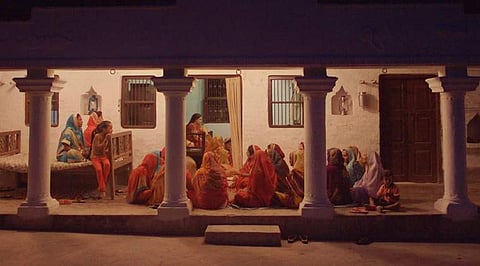

Achal Mishra shows us an ancestral home in a Bihari village over three different times — beginning with 1998, then 2010, and finally 2019 — in his debut feature Gamak Ghar, streaming now on MUBI. He uses different aspect ratios for the three periods. Wes Anderson did the same in The Grand Budapest Hotel. Gamak Ghar, though, is nothing like a Wes Anderson film. It's quite on the other end of the spectrum. There's no whimsy here. If anything, Achal Mishra's film is so realistic it feels like a documentary. However, it is a fictional film that seems to draw liberally from the director's life — the doctor brother's son, who is into theatre, is clearly a stand-in for Achal.
Gamak Ghar begins with the whole family — the grandmother, her three sons and their wives, one daughter, and all the grandchildren — gathered together at the ancestral home to celebrate the birth of the youngest son's child. Achal uses a square aspect ratio for this portion, which highlights the closeness of the family. As time passes, he moves to wider ratios that reflect and emphasise the emptiness of the house. When we first meet this family, the second son, the aforementioned doctor, has already been living in Patna, while the eldest brother and his family have moved to a city. By the end of the first part, we learn that the youngest son is now set to move away to Delhi. The nest is emptying.
When we return to the house in 2010, the family have gathered together for a festival. We find they have all been prospering, except for the oldest grandchild Guddu, who is struggling to hold down a job. The grandmother divides her time between her two living sons (the eldest having passed away). The house, however, isn't doing as well. We see it has visibly aged — the paint is peeling off, the roof seems duller, the doors need fixing. And the house has a gate now, where there was none before. The open, carefree aspect has been replaced by something sadder. It also has new neighbours — bigger, more modern houses being built around it by people who don't live there anymore.
Gamak Ghar tells the story of this home but it also shows us what the house has seen. It's like snapshots of this home over time. Achal Mishra composes his film with only stationary shots. The camera neither moves nor zooms while we're looking. It stays put and lets us observe, only cutting away to another stationary shot. Often, Achal holds on a scene for a good while and we see people moving in and out of the frame. It all adds up to a certain unhurriedness that we would associate with village life (the use of bird sounds throughout adds to the effect). It also simultaneously draws us into the film and keeps us at arm's length from the characters. This seems intentional because this is not a story of the people but of the house itself. In fact, even before we really get a good look at the people, Achal opens the film with shots of house itself — the courtyard with the tulsi plant, the clothesline hung with colourful sarees, the old box-type TV perched on an alcove in the green-painted room. This first portion evokes so much nostalgia.
And nostalgia is an excellent means to form an attachment. We become intimately acquainted with the entrance foyer, main corridor, and courtyard, and develop a fondness for this home that's not our own. In the third and final act, set in 2019, the house is completely run down, its bricks standing naked in most places. We learn it has been all but abandoned by the family after the death of the grandmother. An old, faithful, but not-too-particular housekeeper is taking care of it as best he can. The only gathering we see now is that of a herd of goats stealing in to steal a bite and getting shooed off by the housekeeper. And then we see the roof getting taken apart. Guddu has decided to pull the old house down and renovate it with a newer foundation.
Near the end, there's a lingering shot of the foyer with sunlight streaming in, as the roof above is torn down. Off to the side, we see the photo of the grandfather, which has been a constant through all the years, welcoming everyone at the entrance. This grandfather is the one who built this house. An author and a playwright, he is dead before the film begins, but we hear about him a lot over the course of the first two acts. Guddu walks in taking pictures with his phone (earlier in the film, we see him going around with a film camera and then seeing his younger cousin and aunt wield digital cameras). He notices his grandfather's picture and takes it down, almost as if to keep him from seeing what's happening to the home he built. But after he walks away, we still bear witness. We watch as the roof comes down in rubble. And we keep watching as that final shot of the house being demolished fades out slowly. The shot fades away but the ache remains.